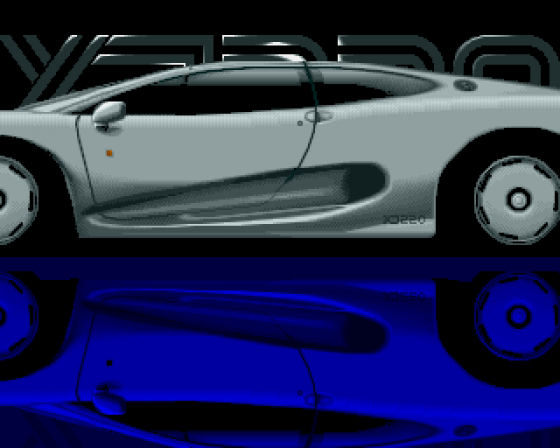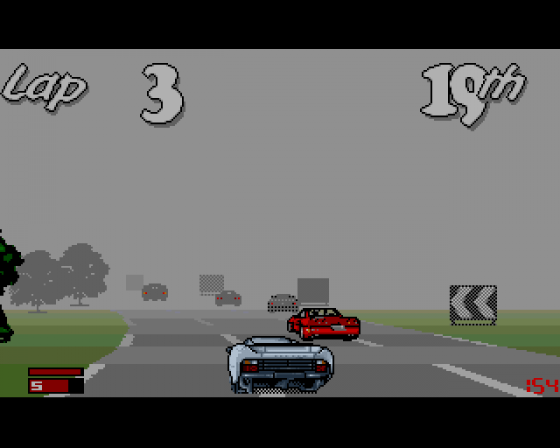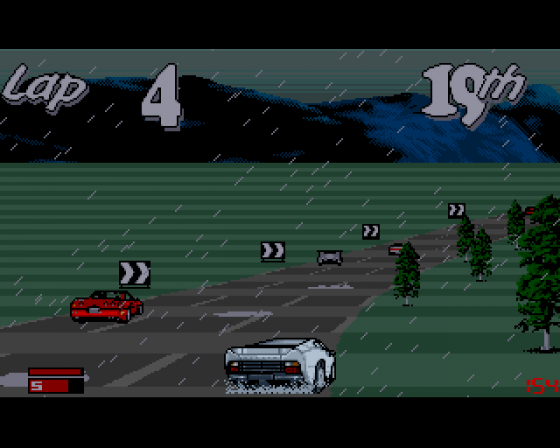
Amiga Power
 1st July 1992
1st July 1992
Categories: Review: Software
Author: Jonathan Davies
Publisher: Core
Machine: Amiga 500
Published in Amiga Power #15
Come on - you must know the story by now. First there was Gremlin's Lotus Turbo Challenge, then there was Lotus II, and now there's Lotus III - oops! Sorry, now there's Jaguar, Core's stab at a sprite-based driving game, and it just begs for Lotus comparisons...
Jaguar XJ220
It seems that Gremlin really started something with their Lotus Turbo Challenge games - not just the resuscitation of the old Pole Position-style racing game, but the introduction of a whole new genre of uncannily similar looking split-screen, two-player racing games. At least, that's what Core must be hoping has happened, because if no-one else does a Lotus-lookalike supercar game, they're going to look rather out-on-a-limb. With Jaguar XJ220, you see, Core have taken Gremlin's seminal Lotus II and replaced the Esprit by a Jaguar XJ220. And, er, that's it.
Okay, perhaps that's not entirely fair. And to make up for it, here's the "descriptive" part of the review with the emphasis firmly placed on the differences between the two games.
Um. (This isn't easy.)

Right, got one. Lotus II featured eight courses, which were played through in order. To complete a course, and progress to the next one, you had to reach all its checkpoints within certain time limits. And that's all there was to it. It worked, but had a rather linear feel. Jaguar takes a rather more flexible approach, revolving around cash. It allows you to play three courses in each of twelve countries (that's 36 altogether, and they're racetracks rather than continuous roads), and once you've played through England's three courses you can choose which country you move onto next. The only snag is that you've got to pay to get there, and the further away it is, the more it'll cost. It's just as well, then, that winning races nets you cash in the form of prize money - the higher-placed you are the more you get. So all you've got to do is make sure you win enough races to keep paying the air fares.
The other thing that'll soak up money is your car. If you don't treat it gently, bits will start to need replacing, and if you can't afford them you're out of the game. This might all sound rather numerical and boring, but it fits in seamlessly with the driving sections and has the enormous advantage that one disastrous performance doesn't always mean The End - you've just got to make good your losses in the next round.
Another difference is the scenery, although it's more of an improvement than a difference. Lotus II looked nice, with its trackside ornamentation and weather conditions, but Jaguar really pulls out all the stops. There are tunnels, bridges, caves (complete with spooky stalactites), waterfalls, marshes, roadworks, the lot. Even Rolf Harris makes an appearance, complete with Stylophone, if you get as far as Australia. The variety is dazzling, and a great incentive to explore all 36 tracks. And Lotus II's weather conditions have all been faithfully transplanted - rain, snow, night-time, fog - plus a slightly over-the-top sandstorm.
The Competition And The Cat

I'm struggling now, but here's another: the cars you race against. Lotus II put you up against other Lotuses. Jaguar has you racing against Ferraris, Lamborghinis, Bugattis, Porches and (oh dear) Corvettes, and they all behave rather more intelligently than Lotus II's. And each manufacturer has his own team racing against you, so as well as working your way up the drivers' rankings, it's up to you and 'Player 2' to do your bit for Jaguar in the constructors championship.
All this said, however, once you've hit the road the similarities flow thick and fast, and it's easy to see how the two games could be confused. Jaguar moves just as fast as Lotus II, the graphics are just as tasty, the road undulates just as, um, undulatingly and the way the car handles is virtually identical (i.e. just as realistic). Even Lotus II's dearth of crashes has been included - you just slow down when you hit something, rather than exploding. The overall result is that Jaguar captures that 'driving feel' perfectly, and is brilliant fun to play and utterly addictive. Er, just like Lotus II. And, just like Lotus II, Jaguar really comes into its own as a firecely competitive two-player game, the only difficulty being in trying to reach an agreement as to when to turn it off.
In fact, the two games are so outrageously similar (and both so good) that I'm not even going to attempt to pick a favourite. What a though. It would be like trying to choose between Macallan and Lagavullin, or Roseanne and Have I Got News For You?, or Sonia and Sabrina. [Eh? - Ed]
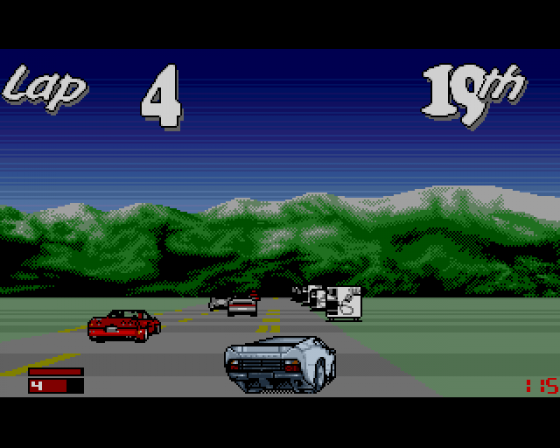
So what do you do? Do you buy this? Do you buy Lotus II (if you haven't already)? Do you buy both? Or do you wait for Lotus III? (Or do you simply pack it all in and take up a less mentally taxing pastime, like brass rubbing?) I suppose that if you really twisted my arm, really twisted it, I'd have said that Jaguar XJ220, with its as-yet-unmentioned track editor, more adventurous - and numerous - courses, and more varied opponents, is probably just (just) about the better buy. But there really isn't much in it.
Forgetting the comparisons for a momemnt, this is really quite a fabulous product that utterly restored my faith in computer games (I've been playing rather too many wargames recently, through no fault of my own). It's been running uninterrupted on my Amiga for days, and see no reason why I'm likely to switch it off in the near future. [I do - here's another wargame! - Ed]
Lotus II Vs. Jaguar XJ220
In an attempt to be as fair as possible to both games, here's a quick break down on the strengths and weaknesses of them both...
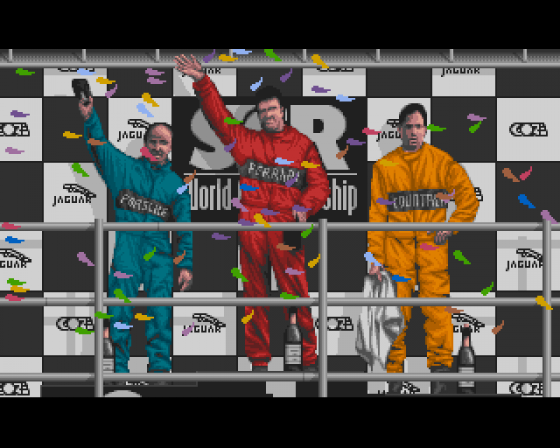
Graphics: Lotus II 8, Jaguar 9 As fast and slick as one could possibly hope for in both games. Lotus's are perhaps more attractively drawn (I'm not too keen on Core's black outlines), but Jaguar heaves a lot more around the screen.
Driveability: Lotus II 9, Jaguar 9 There's really nothing in it. Both games strike the perfect balance between realism and fun.
Addictiveness: Lotus II 8, Jaguar 9 While they're both as unputdownable as each other to start off with, it's likely that Jaguar's flexibility and general 'bigness' will make it the more viable long-term proposition.
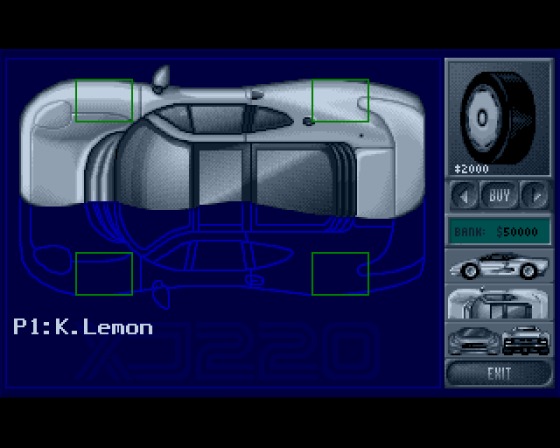
Features: Lotus II 8, Jaguar 8 Lotus II packs a two-computer, four-player option and a choice of two cars, but Jaguar holds it off with its track editor and more complicated moving-around system.
Total: Lotus II 33, Jaguar 35 A photo-finish, but it looks like Jaguar, by a whisker, is the one that gets to squirt champagne all over the place.
The Bottom Line
Uppers: A top quality product from the British Racing Green packaging down to the noise road cones make when they fly over your bonnet. The exploring-the-world element adds a welcome extra dimension, and the actual driving itself is above par.
Downers: It depends on how you feel about lookalike games, of course, but it could hardly be called original. Look upon it as a 'tribute', or an 'elaboration', and you should be okay. Perhaps a little easy, though I'd have to play it for another week or two to be sure.
Arguably the best of the sprite-based driving games, and the most fun two people are likely to have together short of, erm... riding a tandem.



